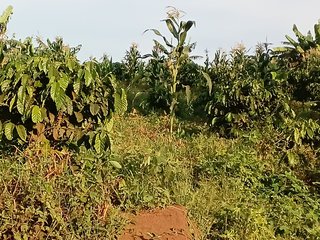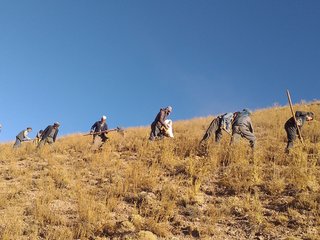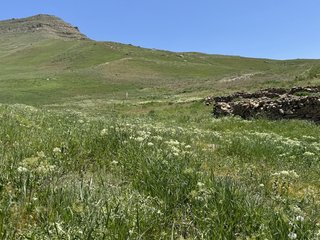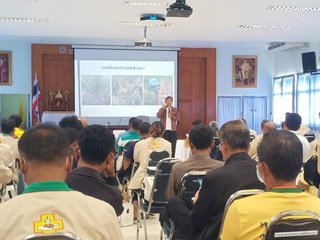Sorting by "Updated at"

Fixation des dunes sur des terres communautaires sylvo-pastorales (cuvettes oasiennes) des départements de Gouré et de Maïné-Soroa [Niger]
La lutte contre l'ensablement des cuvettes oasiennes dans les départements de Gouré et de Maïné-Soroa est réalisée à travers deux techniques de fixation des dunes: (i) la fixation mécanique ou primaire (palissades inertes, fascines) qui stabilise les masses sableuses en mouvement ou empêche la formation de ces masses sableuses sur des obstacles (infrastructures, boisements, bordures de cuvettes), et (ii) la fixation biologique ou définitive qui consiste à créer une couverture végétale permanente sur la dune.
- Compilateur:
- BOUKARY BAKO Mamane Maitourare
- Création:
- 2024-11-29 14:58

Drought-Resilient Agroforestry System [Nigeria]
This technology promotes gender-responsive sustainable land management in Origo Maje, Ogun State, through agroforestry, soil conservation, and climate-smart agriculture practices that empower women and men equally to enhance land productivity, restore degraded ecosystems, and improve livelihoods
- Compilateur:
- Owolabi Adewumi
- Création:
- 2025-01-23 13:09

Intercropping of maize and lablab [Botswana]
Intercropping maize with high-forage legumes, such as Lablab, is a sustainable farming practice embraced by the Gulugwe Cluster Fence members in Mosetse village, Botswana. This method involves growing forage legumes alongside cereal crops like maize, offering a range of environmental, agronomic, and economic benefits through rotational systems.
- Compilateur:
- Retshephile Candy Johny-Matheo
- Création:
- 2024-11-14 14:14

Participatory Understanding of Groundwater Dynamics: Threats and Responsive Management [Inde]
CoDriVE-VI is a participatory approach that integrates local knowledge with scientific data through 3D visual modelling to assess groundwater vulnerability and support sustainable, community-based groundwater management. It overlays surface and subsurface features, enabling villagers to visualize aquifer systems and develop informed water use plans.
- Compilateur:
- Pratik Ramteke
- Création:
- 2025-05-26 11:23

Community seed banks [Inde]
A community-based seed bank system is a locally managed initiative where farmers and community members collect, store, and share seeds to ensure germplasm and food security, preserve crop diversity, and support sustainable agriculture. These banks are governed by community rules.
- Compilateur:
- Pratik Ramteke
- Création:
- 2025-05-23 07:58

Reforestation de la mangrove basé sur un projet [Sénégal]
Le reforestation de la mangrove aide à lutter contre la désertification et la dégradation des terres de plusieurs façons essentielles. Les sites de reboisement se trouvent à l'intérieur de l'AMP (Aire Marine Protégée) de Bamboung, plus précisément dans le secteur de Sadiala. Ce secteur comprend trois sites : Sadiala 1, Sadiala 2, et Sadiala 3, couvrant respectivement 4,89 ha, 0,232 ha, et 0,06 ha, pour un total de 5,182 ha. Les écosystèmes forestiers de ces sites montrent une certaine régénération naturelle, bien que faible. Les efforts de restauration sont cruciaux pour contrer les effets de la salinisation, de l'érosion côtière, et de l'ensablement, exacerbés par des pratiques humaines non durables.
- Compilateur:
- Marthe Therese Ndella DIOUF
- Création:
- 2025-01-09 13:21

Home garden and Agroforestry [Cameroun]
Innovative production of home garden crops using improved technologies to boost growth, making it eco-friendly to both humans and the environment. It was innovative in that we used improved seeds and equally promoted the use of manure in the farming. The crops cultivated in this home garden included; cabbages, celery, leeks, persil and basilic.
- Compilateur:
- Fenwi Linda Ngengeh
- Création:
- 2024-11-13 09:42

Enhanced modern beekeeping technology for household food security, income generation and gender inclusion [Zambie]
Enhanced beekeeping using modern frame hives technology supports participation of women and youths as it is an important source of household income. Traditional forest-based beekeeping requires spending time away from home and is generally not appropriate for family-based women and the youth. In addition modern beekeeping technologies support sustainable natural resource management. Traditional beekeeping requires debarking and cutting down trees for bark hive preparation, which is destructive to the environment.
- Compilateur:
- Tukiya Nkwashi Muke
- Création:
- 2024-11-20 08:07

Contour Rainwater Harvesting Trenches [Zimbabwe]
A trench is a shallow excavation made in the ground to harvest rainwater, control runoff flow, reduce soil erosion, and improve soil moisture retention. Trenches are typically surveyed and designed based on the slope, soil type, and rainfall patterns of the area where they are implemented.
- Compilateur:
- Koetlisi Koetlisi
- Création:
- 2025-01-16 09:46

Multi-Canopy Agroforestry in the Cattle Corridor [Ouganda]
This multi canopy agroforestry technology is implemented in the cattle corridor. Annual crops such as banana (musa acuminata), and maize (Zea mays) together with perennial crops such as coffee (coffea) and tree species (psedopodia microcarpa) are integrated and form the front lower vertical spaces, followed by a level of taller crops. The highest level is formed by tall trees and crops forming the upper canopy, maximizing land use and ecological benefits.
- Compilateur:
- Kamugisha Rick Nelson
- Création:
- 2024-12-04 07:29

Using lift irrigation for afforestation and agroforestry in Kunar [Afghanistan]
Water exploitation is a major issue in Afghanistan, and this technology helps to irrigate an afforestation/agroforestry area (demonstration plot) using surface water (rivers) and solar-powered submersible pump. The construction of reservoirs at the demo plot site ensures efficient water storage and use for irrigation purposes without relying on groundwater. A well-designed pipe irrigation scheme is implemented to distribute water evenly across the site, supporting plant irrigation and growth.
- Compilateur:
- Ahmad Khalid Wiyar
- Création:
- 2025-01-12 11:33

Beekeeping for Conservation of Natural Trees and Forest Reserves [Tanzanie]
Beekeeping is an activity which involves maintenance of bee colonies by using man-made hives within a special selected area. Through beekeeping, conservation of trees is ensured as they provide a potential resource (nectar) required by bees for honey productions as they flower variably. Also, trees are used for hanging of bee hives (ON TREE apiaries) and hence are conserved. Therefore, beekeeping is one among the Sustainable Forest Management practices that has been used for conservation of natural trees and forest reserves.
- Compilateur:
- LINDA SHIO
- Création:
- 2025-01-16 10:19

Approche 4L (Land management, social Learning, resilient Landscape, sustainable Livelihoods) pour la restauration des paysages et des écosystèmes forestiers [Madagascar]
L’approche 4L intègre la gestion des terres, l'apprentissage social, la résilience des paysages et les moyens de subsistance durables pour une gestion équilibrée des ressources naturelles. Elle favorise une gouvernance participative et adaptative afin d’assurer la durabilité environnementale et socio-économique.
- Compilateur:
- Dimby RAHERINJATOVOARISON
- Création:
- 2025-02-12 11:24

Restoration in the High Conservation Value Forests (HCVF) through community-led initiatives in Paktya [Afghanistan]
An integrated community-led initiative has been established to restore the degraded forests in Paktya province. This initiative focuses on setting up nurseries and incorporates both indigenous and scientific knowledge to cultivate climate-resilient species, such as Cedrus deodara and Pinus gerardiana. These efforts have enhanced the community’s knowledge and skills in sapling production and transplantation, leading to significant improvements in the productivity of these key species, which holds substantial ecological, social, cultural and economic values.
- Compilateur:
- Mohammad Wazir Ahmadzai
- Création:
- 2024-12-09 05:30

Community based reforestation initiatives to restore degraded forest and rangeland [Afghanistan]
Community-driven reforestation initiative that involves awareness-raising, capacity building, feasibility analysis, and collaboration among various stakeholders to address land degradation and promote sustainable forest and rangeland management
- Compilateur:
- Mohammad Aslam Hasand
- Création:
- 2025-01-12 07:32

Reseeding local fodder species in Bamyan rangelands using indigenous and scientific methods [Afghanistan]
Artificial reseeding is a key method for restoring degraded rangelands. It involves reintroducing native, palatable fodder species to improve vegetation cover, soil health, and biodiversity. This process boosts forage for grazing animals, stabilizes soil, and helps combat desertification, enhancing ecosystem health and productivity.
- Compilateur:
- Gul Nabi Khan Noorani
- Création:
- 2024-11-13 07:26

Implementing Site Quarantine to reduce rangeland degradation in the highlands of Badghis [Afghanistan]
Restoring degraded rangelands through quarantine in Qadis district, Badghis Afghanistan.
- Compilateur:
- Shamsulhaq Shams
- Création:
- 2024-12-19 06:35

Agroforesterie intégrée et gestion de l'eau [Côte d'Ivoire]
La technologie GDT mise en œuvre à Zahakro, dans la localité de Toumodi, repose sur l’association d’arbres et de cultures afin d’améliorer la fertilité des sols et la rétention d’eau.
- Compilateur:
- Alexandre KOFFI
- Création:
- 2024-11-12 15:27

Reconstitution of Soils Approach [Italie]
Reconstitution of soils is a patented pedotechnology that brings benefits to degraded soils. Simultaneously, it raises awareness of the potential of restoring soil fertility through recycling. The approach starts with the identification of the soil issue, and the technology is then planned, implemented and promoted through a consortium.
- Compilateur:
- Chiara Cassinari
- Création:
- 2024-10-17 13:41

Crop rotation and Furrow Planting : A Sustainable Potato Cultivation. [Bangladesh]
If potatoes are cultivated using Rotational and Furrow planting methods, soil quality is maintained, and Production targets are met. Potato Farming is a women-friendly production process through which women can become self-relient.
- Compilateur:
- Elias Murmu
- Création:
- 2025-02-18 04:55

Systèmes de gestion de l'eau à travers les cuvettes en pierres sèches [Algérie]
Les cuvettes en pierres sèches, une technique ancienne, trouvent leurs racines dans des traditions de gestion de l'eau. Cette méthode utilise des structures en pierre sans mortier pour créer des cuvettes qui captent efficacement l'eau de ruissellement.
- Compilateur:
- Fatiha Guerrouche
- Création:
- 2024-11-13 11:17

Mise en défens des parcours steppiques [Algérie]
La restauration et la réhabilitation des parcours steppiques reposent sur des initiatives majeures, notamment les mises en défens et les plantations pastorales avec des espèces robustes comme Atriplex canescens, Tamarix gallica L. Ces mesures ont pour objectif de contrer la dégradation des écosystèmes steppiques, fragilisés par la désertification et le surpâturage.
- Compilateur:
- Abdelhakim Zidi
- Création:
- 2024-11-12 16:35

INTEGRATED AGRICULTURE-BASED LAND USE IN AREAS WITH SALINE SOILS [Thaïlande]
Salinity and associated land degradation in parts of the Northeast of Thailand limits production. Knowledge of saline soil management was integrated into an organic agriculture system: dolomite application adjusted pH levels, manure increased the soil's organic matter, while fermented bio-extracts stimulated root systems. Yields of chili pepper and parsley improved greatly.
- Compilateur:
- Laksamee Mettpranee
- Création:
- 2024-08-08 04:19

Landscape Restoration through Agroforestry [Nigeria]
The technology (Agroforestry) integrates trees, crops, and livestock within a synergistic system to optimize land use and productivity. This innovative approach enhances soil health, conserves biodiversity, and strengthens climate resilience while supporting sustainable livelihoods for local communities.
- Compilateur:
- Mika'il Haruna Daya
- Création:
- 2024-11-12 13:49

Experiential Learning Tools for Sustainable Water Management [Inde]
The project “Scaling up experiential learning tools for sustainable water governance in India” aimed at enhancing sustainable water management at scale by improving the capacities of 1,500 rural communities covering 105,000 households directly and 2,000 communities covering 140,000 households indirectly in six Indian states to manage water more sustainably. This was achieved through experiential learning from collective action games, structured community debriefings, and participatory water planning tools that contribute to greater awareness and improved governance, inducing behavioural change toward more sustainable water governance and management. The work was jointly conducted by the Foundation for Ecological Security, India (FES), the International Food Policy Research Institute (IFPRI) and the International Crops Research Institute for the Semi-Arid Tropics (ICRISAT).
- Compilateur:
- Vishwambhar Duche
- Création:
- 2024-08-19 10:48

Planting Pits in Conservation Farming for Improved Soil Health and Sustainable Land Management [Zimbabwe]
Conservation farming prevents the degradation of soil structure, the loss of organic matter and soil biodiversity, while maintaining and restoring soil fertility. Thereby it fosters optimal conditions for crop growth and development while contributing to climate change adaptation and mitigation.
- Compilateur:
- Fadziso Mawunganidze
- Création:
- 2024-11-27 01:26

Cordons de pierres, une technologie antiérosive [Mali]
Les cordons pierreux sont la technologie la plus répandue et la plus efficace de gestion des terres dégradées de la commune de Bossofala. Dans le village de Néguébabougou, les agriculteurs dont les terres agricoles sont situées sur une pente ou aux flancs des monticules, l’utilisent comme mécanisme approprié pour contrer l’érosion hydrique, maintenir la fertilité des sols et maximiser les rendements.
- Compilateur:
- Ousmane BERTHE
- Création:
- 2024-11-22 12:45

Slope division for erosion control [Suisse]
A field at risk for erosion by water is divided so that a grass strip prevents soil loss and further damage to the field and the streets during a heavy rainfall.
- Compilateur:
- Deborah Niggli
- Création:
- 2015-05-19 20:26

Multi-storey intercropping with coffee and fruit trees [Viêt Nam]
Robusta coffee in the Central Highlands of Vietnam is intercropped with pepper vines and fruit trees thus increasing the total planting density. This leads to higher land equivalent ratios compared to monocropping, thereby increasing land use efficiency, profitability, soil protection and resilience.
- Compilateur:
- Carlos Gil Picon
- Création:
- 2024-11-08 10:34

EXTENSION OF SUNN HEMP AS A SOIL AMENDMENT IN SALINE SOILS [Thaïlande]
An outreach programme aims to educate farmers about the benefits of ploughing rice stubble into the soil and incorporating green manure crops such as sunn hemp - as well as other sustainable practices. Groups of farmers are formed, and they are assisted by various organisations including the Land Development Department and volunteer "soil doctors".
- Compilateur:
- Laksamee Mettpranee
- Création:
- 2024-08-06 08:49

Drought-resistant crops [Suisse]
In response to changing environmental conditions, it can be valuable to adopt new plant varieties that offer benefits such as drought tolerance. The technology described covers one such response in Switzerland.
- Compilateur:
- Seraina Lerf
- Création:
- 2022-05-24 10:30

A Water-Energy-Food (WEF) efficient net house [Émirats arabes unis]
The technology integrates off-grid soil-less cultivation within a net house, utilizing solar-powered root zone cooling and ultra-low energy irrigation, thus significantly enhancing water and energy efficiency for sustainable agriculture in arid regions. This innovation is a key contribution within the Water-Energy-Food Nexus, addressing the unique challenges of food production in the Middle East.
- Compilateur:
- Joren Verbist
- Création:
- 2024-08-25 14:55

Reconstitution of Soils [Italie]
Reconstitution of soils is a pedotechnique based on the treatment of organic and non-organic pedomaterials to achieve benefits in areas with barren, degraded, desertified and/ or sealed soils.
- Compilateur:
- Chiara Cassinari
- Création:
- 2024-10-09 13:53

Rock-Packed Halfmoon with Native Grass Seeding [Zimbabwe]
A half-moon pit, also known as an infiltration pit, is a semi-circular rainwater harvesting structure designed to capture and store runoff water, primarily in arid and semi-arid regions. Its design and implementation play a crucial role in reducing soil erosion, improving soil moisture retention, and enhancing vegetation growth.
- Compilateur:
- Koetlisi Koetlisi
- Création:
- 2024-12-20 09:00

Shallow tillage (15-20cm) [Tunisie]
Shallow tillage involves disturbing the upper layer of soil without deep ploughing. It aims to provide a good seedbed, incorporate manure, control weeds, and enhance water infiltration while minimizing soil erosion and compaction. A machine tiller has recently replaced animal traction for this purpose.
- Compilateur:
- Wiem Haouari
- Création:
- 2024-11-15 22:10

Pares-feux agricoles [Madagascar]
Les terres cultivées sont résistantes au feu et peuvent servir de coupe-feu en raison de la présence d'humidité et du manque de combustible sec. La mise en place de coupures de combustible par l’agriculture permet de créer des paysages en mosaïque résistants aux incendies, tout en réduisant la dégradation des forêts et la déforestation.
- Compilateur:
- Dimby RAHERINJATOVOARISON
- Création:
- 2024-11-12 13:48

Association Maïs et Niébé [Madagascar]
L'association de cultures de Maïs avec les légumineuses volubiles améliore la fertilité du sol et constitue une source de revenus rapide pour les petits exploitants. Le Niébé rouge, appelé localement "Lojy zazamena", est la légumineuse la plus utilisée mais il existe aussi d'autres variétés de Niébés (Vigna unguiculata) volubiles qui s'adaptent bien aux conditions du milieu de la Région (Baboka, Rapaenta).
- Compilateur:
- Dimby RAHERINJATOVOARISON
- Création:
- 2024-11-14 18:51

Compost liquide [Madagascar]
Le compost liquide s'obtient par macération d'un mélange de déjection animale et de matières végétales fraîches, incluant des plantes aux propriétés insectifuges, en milieu aqueux. Il peut être utilisé comme substitution aux engrais minéraux et être employé comme action préventive contres les ennemis des cultures. Il peut être utilisé pour tous types de cultures, mais particulièrement adapté aux cultures maraîchères.
- Compilateur:
- Dimby RAHERINJATOVOARISON
- Création:
- 2024-11-15 10:28

Improved Forest management [Allemagne]
There are opportunities for robust forest management strategies in Germany to enhance land-based climate change mitigation. Through targeted measures, forest management can contribute to the continuous uptake of CO2 from the atmosphere by trees, and to the increase of carbon stocks in living and dead biomass, as well as in the soil.
- Compilateur:
- Anke Benndorf
- Création:
- 2024-04-23 21:45

Organic Agriculture with Reduced Tillage [Ukraine]
This organic agriculture technology combines reduced tillage with organic farming practices to enhance soil health, increase carbon sequestration, and maintain sustainable agricultural productivity.
- Compilateur:
- Natalia Prozorova
- Création:
- 2024-11-26 16:12
- . . .
























































































































































































































































